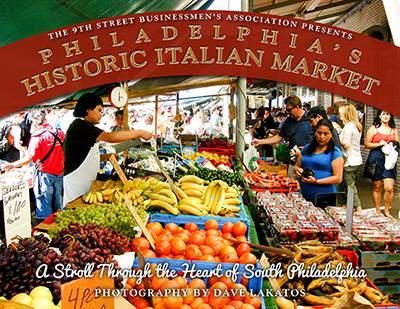Filadelfia è una delle città più antiche d’America e gli italo americani che vi abitano costituiscono una comunità storica. L’immigrazione italiana iniziò qui in piena epoca coloniale nel XVIII secolo ed era costituita principalmente di italiani di ambienti alto-borghesi del settentrione d’Italia, mentre quella di massa ebbe luogo nel secolo seguente e prevalentemente da aree meridionali. In poco più di 80 anni, la comunità italiana crebbe da 1.600 a 600,000 individui, cioé ben un terzo dell’intera popolazione della città. Oggi, la zona di maggiore attrazione di questo passato è rappresentata dal mercato italiano. Chiamata comunemente South 9th Street Curb Market, o semplicemente 9th Street, è un’area interna al quartiere Bella Vista, fondato appunto dagli immigrati italiani. Qui si possono trovare tante prelibatezze tutte tricolori e molti che raccontano di un’Italia che non esiste più ma che, nell’immaginario collettivo, resta ancora esattamente così, la mecca del gusto e della tradizionale patriarcale così diversa e lontana dall’America.
The city of Philadelphia holds a special place in America’s heart. The 1776 signing of the Declaration of Independence in the Pennsylvania State House, now known as Independence Hall, the home of the iconic Liberty Bell and other American Revolutionary sites in this city are forever part of our country’s rich history.
Italians have been part of the city’s history since colonial times. In 1665, a group of Italian protestants came to the area seeking religious asylum. When the English took over Philadelphia, it is believed that some of that original group came to live in Philly. William Penn had visited Italy and, as a Quaker, believed in freedom of religion. In 1773, Old St. Joseph’s Church was established. Here, early Italians were able to worship alongside other European Catholics. The first Italian was baptized in the church in 1758. Later, the basement of the church would serve as the meeting place for Italian Catholics before the formation of the first Italian Catholic church.
In 1753, Ben Franklin at the Philadelphia College offered Italian language. In 1779, Filippo Mazzei came to Philly to present to the American Philosophical Society. He is credited with the quote “All men are by nature equally free and independent,” which became part of the Declaration of Independence.
By 1880, the number of Italians born in Philadelphia had risen to 1,600 and by 1900 the city had a large Italian presence. Most lived in South Philadelphia in an area known as the Italian Market. By the 1970’s, the Italian population had soared to over 600,000, representing one-third of the city’s population. In 1972, Frank Rizzo became the first Italian American mayor.
The most well-known part of Philadelphia’s Little Italy is still the Italian Market. This area has contained many Italian-influenced grocery stores, cafes, restaurants, bakeries, cheese shops, butcher shops, and more since the 19th century. Running along approximately 10 city blocks, the area is one of the oldest and largest open-air markets in America. The Italian Market is also home to two of the most famous purveyors of cheesesteaks in the world: Pat’s and Geno’s.
Last month marked the annual Italian Market Festival, also Philly’s largest block party. With the procession of saints, greasy pole contest, live musical entertainment, half ball tournament, and, of course, plenty of delicious food, this festival is surely one not to be missed.
The deep roots of both American and Italian history certainly make Philadelphia a special place.



